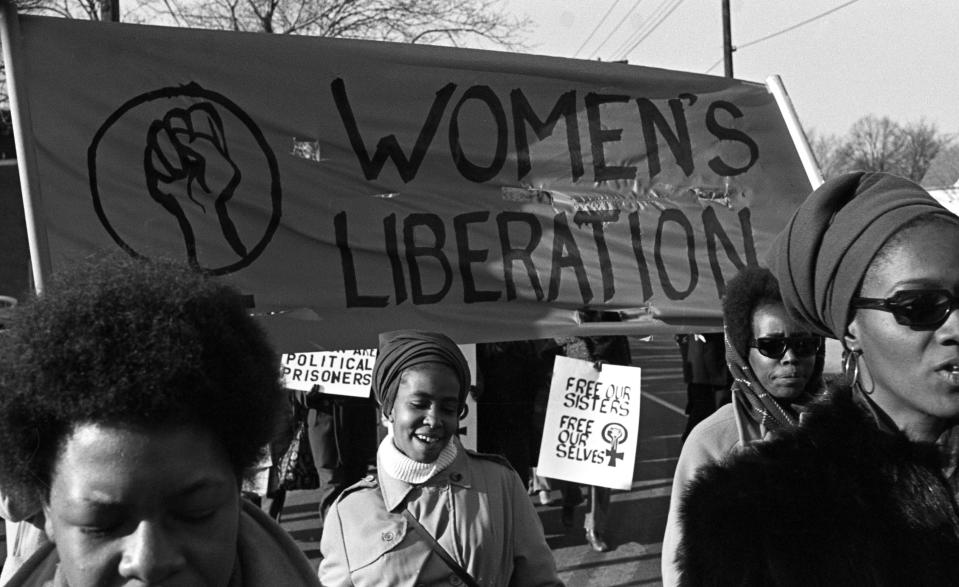The Women's March, under pressure from controversy, could implode. Here's why that might be OK.

Women’s Marches in New Orleans, Chicago and Eureka, Calif., have all been canceled. Other local organizations — in New York, Rhode Island and Washington state — have splintered off to create alternative events. Still others, including groups in Los Angeles and Florida, have declared they are not aligned with the national Women’s March, which has had a cloud hovering over it since at least last March.
That’s when charges of anti-Semitism flared in response to co-president Tamika Mallory’s apparent support of the Nation of Islam’s Louis Farrakhan, whose frequent hate speech about Jews (whom he has called “wicked deceivers” and “the synagogue of Satan”) and gay people has raised official alarm bells with the anti-bigotry Southern Poverty Law Center. Since then, the at-first-tepid Women’s March response, combined with the rise in anti-Jewish hate crimes, which rose 37 percent from 2016 to 2017, according to the FBI, has kept the controversy alive.
It’s all caused a hurtful, growing rift among Women’s March activists. Leaders Mallory, Linda Sarsour, Bob Bland and Carmen Perez have refused to step down (as they’ve been asked to do by those including founder Teresa Shook) and have stood firm in not denouncing Farrakhan while also speaking out against anti-Semitism and homophobia and apologizing for any hurt.
“Every member of our movement matters to us — including our incredible Jewish and LGBTQ members,” the Women’s March home page notes. “We are deeply sorry for the harm we have caused, but we see you, we love you, and we are fighting with you.”
Mallory and Bland made a rare television appearance on The View on Monday morning — and Mallory said, “I don’t agree with many of Minister Farrakhan’s statements” — just days away from the third annual Women’s March, which is scheduled to kick off on Jan. 19 in Washington, D.C., and in cities across the nation. In the weeks leading up to it, a steady clip of activists and writers have been speaking out against the movement’s direction and leadership; still others, including some Jewish activists, are standing firm in their support.

It has all led many to make a worried observation: Just two years into the movement that drew an estimated million fired-up women to Washington, D.C., in 2017, the Women’s March appears to be under threat of implosion.
Where does the rift leave women across the nation who may feel disheartened by the controversy and worried about where the movement will go from here?
Experts in the history of social movements assure Yahoo Lifestyle that it’s important to keep perspective and understand that infighting, the splintering of focus and a clash of identity politics are all just part of the deal.
“The Women’s March is huge and expressly diverse — and is not only for women’s rights but for the rights of immigrants, for the environment, for reproductive rights. It was a huge and diverse event from the beginning, with all these people brought together by this perceived threat,” says Rachel Einwohner, a Purdue University professor of sociology with expertise in protest and resistance. “When you have that huge and diverse of a constituency, over time, divisions and disputes and disagreements come up. That is very common, and the anti-Semitism is very, very painful to many people. But it could’ve been something else equally painful to someone else.”
Or, as Zakiya Luna, assistant professor of sociology at the University of California Santa Barbara, tells Yahoo Lifestyle about the infighting, “It’s par for the course.”
Luna, who focuses her research on the relationship between the women’s movement and women of color, says: “There have been race, class and other conflicts from the beginning, with the suffragists. So this is not the first time there have been controversies around race in the women’s movement.” But, she adds, “It’s important to stay engaged in the conversation and remember that making change isn’t easy.”
A difference now, she adds, is that “social media allows people on a global scale to follow conflicts more than [in the past],” including the recent past, such as during the 2004 March for Women’s Lives, which Luna has studied and which had its own internal struggles.

“There were conflicts and controversies, but it wasn’t as easy for people to see it [then] unless they were involved,” she says. “It’s easy to forget that because we are now inundated with news updates and social media.” Luna adds that conflict within social movement organizing can be “small,” such as over who a group has invited to speak at a monthly meeting, “but for the people involved, it might feel just as important. So a harder part of the movement is that emotional work,” she explains. “And it’s difficult when every move you make will potentially be on Twitter.”
For further perspective, Luna notes, “It’s important to keep in mind that the Women’s March is part of the women’s movement, and that there are literally hundreds of organizations doing the work throughout the nation.” So if you are conflicted about whether or not to attend an official Jan. 19 event this year, Luna has a suggestion. “Ask yourself: Where do you want to make an impact? Do you know what’s going on locally? On a state level? No matter people’s points of view, there is space for them in movements.”
Luna, who is in the midst of analyzing responses to a survey of the Women’s Marches attendees and why women will or will not attend this time, explains how she helps her students understand the potential for conflict in social movements. “I always encourage my students to think about being in a room with 30 people; they have different ideas, experiences and visions about how to reach a goal,” and then imagine that in a forum as massive as the Women’s March. (Judging from Luna’s early survey findings, women are not attending the D.C. march this time for reasons ranging from wanting to put their energy into local efforts to simply not having “the capacity”; others are bowing out because of the controversy.)

“The women’s movement in particular, and social movements in general, have a history of these divisions coming up — of one group of people feeling left out by a gender, ethnicity, sexuality, privilege that overrides others,” concurs Jo Reger, professor of sociology and an expert in social movements at Oakland University in Michigan. “So it’s not a new phenomenon that there’s some sort of dissension and division in these marches.”
That’s because when a dynamic exists in a society at large — anti-Semitism, for example — it’s bound to show up within social movements, too. “People come together around a specific issue, but they bring all the societal baggage along with them,” Reger explains.

Something we can see throughout history, though, is that when social movements go through turmoil that leads to dissension and splintering, “it’s not necessarily a bad thing,” Reger notes. “It often enlarges the movement, addresses issues that need to be addressed and allows people to organize in ways that make more sense as them. We think of division as bad, but it can often be beneficial.”
With local marches splitting off from the national organization, for example, “It tells us these communities are active and engaged, but they’re protesting in a way that makes sense for who they are.”

Another important lesson from the past: It’s difficult to keep high levels of mobilization year after year, as the Women’s March has called for. “People are often sparked by an event — or something like a presidential election turning out in a way that they found threatening,” Reger says. “But often, over time, that sense of threat decreases, so you can also see participation decreasing. … It’s a common pattern with all social movements, especially when people see something that’s somewhat hopeful. The past midterm elections, for example, might be making them feel a little optimistic.”
A cogent reminder about the timeless reality of infighting can be found in a 1978 essay, “Crises and Conflicts in Social Movement Organizations,” written by longtime feminist civil rights activist Jo Freeman. In its early stages, she wrote, “a movement faces a series of contradictions. It is torn by conflicting demands which constantly threaten to tear it apart, and which can never be completely resolved because each side reflects an essential element in the movement’s functioning. For a movement to opt in favor of one faction over the other usually leads to the destruction of the movement by either wiping it out completely or reducing it to an innocuous group. Instead, it is necessary to maintain a dynamic tension between the different pressures. This is not easy, which is one of the reasons social movements rarely last very long.”
Today, Freeman tells Yahoo Lifestyle, “There’s always going to be an internal conflict based on something.” In the early women’s liberation movement, for example, “Lesbianism was the big divide. … In the ’60s, denouncing the women’s movement as being run by lesbians was a bad thing,” she says, referring to National Organization of Women founder Betty Friedan, who famously denounced lesbian activists as a “lavender menace.” What the “bad thing” is, Freeman notes, “shifts over time — for opponents, quasi-opponents and even insiders.”
But, she adds, “All movements are inherently unstable. There’s no such thing as a permanent social movement. They rise, they peak, they fall. Instability, divisiveness, that’s normal.”
When it comes to the instability of the Women’s March, however, “two years is extremely short, when I look back and compare with the movements that I’ve been a part of. Still, will the thing break up and die? Probably not — the sentiments are too strong. But it could change.”
Einwohner points out that the sheer size of the Women’s March movement, while providing strength, also adds to the difficulty when it comes to doing repair work.
“If it was a small, local activist group with disputes, then people could come together, recognize each other’s pain and try to move forward,” she says. “But the problem here is it is so huge, how do you get gazillions of women together in one room to hash it out? Social media is trying, but this type of discussion is hard, and perhaps, in the absence of a real face-to-face, it’s hard to address the pain. That’s the flip side of having a beautifully huge, diverse movement. … The challenge is to keep it together despite the diversity.”
Read more from Yahoo Lifestyle:
Women’s March cancels rally over concerns it would be ‘overwhelmingly white’
‘We’re sex workers and we vote’: Women’s March event shines spotlight on marginalized group
Follow us on Instagram, Facebook and Twitter for nonstop inspiration delivered fresh to your feed, every day.


